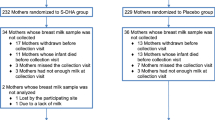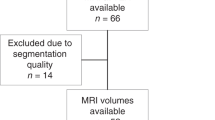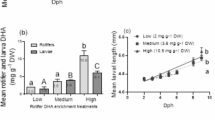Abstract
Docosahexaenoic acid (DHA), a 22-carbon, highly unsaturated, n-3 fatty acid, is important for optimal nervous system function. In this study, designed to quantify how preformed dietary DHA regulates metabolic pathways in vivo, 8-d-old rat pups were divided into four groups and fed artificial rat milk diets. One group was fed formula with deuterium-labeled LNA (d5-LNA) as the only source of n-3 fatty acids, and a second group was fed formula that contained d5-LNA and unlabeled DHA. Two additional groups were dam-reared to permit analysis of fatty acyl pool sizes at postnatal days 8 and 28. The dams were fed a diet that contained 3% unlabeled LNA. DHA in brain and liver was analyzed. Our study demonstrated that preformed DHA in the diet markedly decreased the amount of biosynthesized DHA that accumulated in the brain and the liver. Surprisingly, ∼40% of the DHA that was newly acquired during this period in the “LNA” group was unlabeled. Because there were no unlabeled n-3 fatty acids in this diet, this DHA must have been derived from body stores of n-3 fatty acids. Thus, body stores can be a significant source of brain DHA in animals that are fed LNA as the only source of n-3 fatty acids.
Similar content being viewed by others
Log in or create a free account to read this content
Gain free access to this article, as well as selected content from this journal and more on nature.com
or
Abbreviations
- AA:
-
arachidonic acid
- DHA:
-
docosahexaenoic acid
- d5-DHA:
-
deuterium-labeled docosahexaenoic acid
- d5-LNA:
-
deuterium labeled α-linolenic acid
- DPAn-6:
-
docosapentaenoic acid
- EE:
-
ethyl ester
- EPA:
-
eicosapentaenoic acid
- GC:
-
gas chromatography
- LCP:
-
long-chain polyunsaturate
- LNA:
-
α-linolenic acid
- MS:
-
mass spectrometry
References
Salem N Jr Litman B, Kim HY, Gawrisch K 2001 Mechanisms of action of docosahexaenoic acid in the nervous system. Lipids 36: 945–959
Okuyama H, Kobayashi T, Watanabe S 1996 Dietary fatty acids—the N-6/N-3 balance and chronic elderly diseases. Excess linoleic acid and relative N-3 deficiency syndrome seen in Japan. Prog Lipid Res 35: 409–457
Carrie I, Smirnova M, Clement M, DE JD, Frances H, Bourre JM 2002 Docosahexaenoic acid-rich phospholipid supplementation: effect on behavior, learning ability, and retinal function in control and n-3 polyunsaturated fatty acid deficient old mice. Nutr Neurosci 5: 43–52
Reisbick S, Neuringer M, Hasnain R, Connor WE 1994 Home cage behavior of rhesus monkeys with long-term deficiency of omega-3 fatty acids. Physiol Behav 55: 231–239
Moriguchi T, Greiner RS, Salem N Jr 2000 Behavioral deficits associated with dietary induction of decreased brain docosahexaenoic acid concentration. J Neurochem 75: 2563–2573
Greiner RS, Moriguchi T, Slotnick BM, Hutton A, Salem N 2001 Olfactory discrimination deficits in n-3 fatty acid-deficient rats. Physiol Behav 72: 379–385
Catalan J, Moriguchi T, Slotnick B, Murthy M, Greiner RS, Salem N Jr 2002 Cognitive deficits in docosahexaenoic acid-deficient rats. Behav Neurosci 116: 1022–1031
Ahmad A, Murthy M, Greiner RS, Moriguchi T, Salem N Jr 2002 A decrease in cell size accompanies a loss of docosahexaenoate in the rat hippocampus. Nutr Neurosci 5: 103–113
Emken EA, Adlof RO, Rakoff H, Rohwedder WK, Gulley RM 1990 Metabolism in vivo of deuterium-labelled linolenic and linoleic acids in humans. Biochem Soc Trans 18: 766–769
Salem N Jr Wegher B, Mena P, Uauy R 1996 Arachidonic and docosahexaenoic acids are biosynthesized from their 18-carbon precursors in human infants. Proc Natl Acad Sci USA 93: 49–54
Carnielli VP, Wattimena DJ, Luijendijk IH, Boerlage A, Degenhart HJ, Sauer PJ 1996 The very low birth weight premature infant is capable of synthesizing arachidonic and docosahexaenoic acids from linoleic and linolenic acids. Pediatr Res 40: 169–174
Sauerwald TU, Hachey DL, Jensen CL, Heird WC 1997 New insights into the metabolism of long chain polyunsaturated fatty acids during infancy. Eur J Med Res 2: 88–92
Su HM, Huang MC, Saad NM, Nathanielsz PW, Brenna JT 2001 Fetal baboons convert 18: 3n-3 to 22:6n-3 in vivo. A stable isotope tracer study. J Lipid Res 42: 581–586
Innis SM 1992 Human milk and formula fatty acids. J Pediatr 120: S56–S61
Sinclair AJ 1975 Incorporation of radioactive polyunsaturated fatty acids into liver and brain of developing rat. Lipids 10: 175–184
Su HM, Bernardo L, Mirmiran M, Ma XH, Corso TN, Nathanielsz PW, Brenna JT 1999 Bioequivalence of dietary alpha-linolenic and docosahexaenoic acids as sources of docosahexaenoate accretion in brain and associated organs of neonatal baboons. Pediatr Res 45: 87–93
Woods J, Ward G, Salem N Jr 1996 Is docosahexaenoic acid necessary in infant formula? Evaluation of high linolenate diets in the neonatal rat. Pediatr Res 40: 687–694
Abedin L, Lien EL, Vingrys AJ, Sinclair AJ 1999 The effects of dietary alpha-linolenic acid compared with docosahexaenoic acid on brain, retina, liver, and heart in the guinea pig. Lipids 34: 475–482
Bowens RA, Clandinin MT 2000 High dietary 18: 3n-3 increases the 18:3n-3 but not the 22:6n-3 content in the whole body, brain, skin, epididymal fat pads, and muscles of suckling rat pups. Lipids 35: 389–394
Brenner RR, Peluffo RO 1967 Inhibitory effect of docosa-4,7,10,13,16,19-hexaenoic acid upon the oxidative desaturation of linoleic into gamma-linolenic acid and of alpha-linolenic into octadeca-6,9,12,15-tetraenoic acid. Biochim Biophys Acta 137: 184–186
Dobbing J 1990 Vulnerable periods in developing brain. In: Dobbin J (ed) Brain, Behaviour, and Iron in the Infant Diet. Springer Verlag, London, pp 1–17
Ward G, Woods J, Reyzer M, Salem N Jr 1996 Artificial rearing of infant rats on milk formula deficient in n-3 essential fatty acids: a rapid method for the production of experimental n-3 deficiency. Lipids 31: 71–77
Kanno T, Koyanagi N, Katoku Y, Yonekubo A, Yajima T, Kuwata T, Kitagawa H, Harada E 1997 Simplified preparation of a refined milk formula comparable to rat's milk: influence of the formula on development of the gut and brain in artificially reared rat pups. J Pediatr Gastroenterol Nutr 24: 242–252
Harris WS, Hustvedt BE, Hagen E, Green MH, Lu G, Drevon CA 1997 N-3 fatty acids and chylomicron metabolism in the rat. J Lipid Res 38: 503–515
Hamazaki T, Urakaze M, Makuta M, Ozawa A, Soda Y, Tatsumi H, Yano S, Kumagai A 1987 Intake of different eicosapentaenoic acid-containing lipids and fatty acid pattern of plasma lipids in the rats. Lipids 22: 994–998
Folch AC, Lees M, Sloane-Stanley GM 1957 A simple method for isolation and purification of total lipids from animal tissues. J Biol Chem 226: 497–509
Salem N Jr Reyzer M, Karanian J 1996 Losses of arachidonic acid in rat liver after alcohol inhalation. Lipids 31:( suppl) S153–S156
Morrison WR, Smith LM 1964 Preparation of fatty acid methyl esters and dimethylacetals from lipids with boron fluoride–methanol. J Lipid Res 5: 600–608
Lepage G, Levy E, Ronco N, Smith L, Galeano N, Roy CC 1989 Direct transesterification of plasma fatty acids for the diagnosis of essential fatty acid deficiency in cystic fibrosis. J Lipid Res 30: 1483–1490
Pawlosky RJ, Sprecher HW, Salem N Jr 1992 High sensitivity negative ion GC-MS method for detection of desaturated and chain-elongated products of deuterated linoleic and linolenic acids. J Lipid Res 33: 1711–1717
Lim S-Y, Moriguhci T, Lefkowitz B, Loewke J, Majchrzak S, Hoshiba J, Salem N Jr 2003 Artificial feeding of an n-3 essential fatty acid deficient diet leads to a loss of brain function in the first generation. Huang Y-S, Lin S-J, Huang P-C Essential Fatty Acids and Eicosanoids. American Oil Chemists Society Press, Champaign, IL 122–131
Salem N Jr 1989 Omega-3 fatty acids: molecular and biochemical aspects. In: Spiller GA, Scala J (eds) New Protective Rolesfor Selected Nutrients. Alan R Liss, Inc, New York pp 109–228
Greiner RS, Catalan JN, Moriguchi T, Salem N Jr 2003 Docosapentaenoic acid does not completely replace DHA in n-3 FA-deficient rats during early development. Lipids 38: 431–435
Chen ZY, Cunnane SC 1992 Early postnatal development in the rat is characterized by accumulation of highly unsaturated triacylglycerols. Pediatr Res 31: 47–51
Nakamura MT, Cho HP, Clarke SD 2000 Regulation of hepatic delta-6 desaturase expression and its role in the polyunsaturated fatty acid inhibition of fatty acid synthase gene expression in mice. J Nutr 130: 1561–1565
Pawlosky RJ, Hibbeln JR, Lin Y, Goodson S, Riggs P, Sebring N, Brown GL, Salem N Jr 2003 Effects of beef- and fish-based diets on the kinetics of n-3 fatty acid metabolism in human subjects. Am J Clin Nutr 77: 565–572
Bowena RA, Clandinin MT 2000 High dietary 18: 3n-3 increases the 18:3n-3 but not the 22:6n-3 content in the whole body, brain, skin, epididymal fat pads, and muscles of suckling rat pups. Lipids 35: 389–394
Jensen RG 1999 Lipids in human milk. Lipids 34: 1243–1271
Kuriki K, Nagaya T, Tokudome Y, Imaeda N, Fujiwara N, Sato J, Goto C, Ikeda M, Maki S, Tajima K, Tokudome S 2004 Plasma concentrations of (n-3) highly unsaturated fatty acids are good biomarkers of relative dietary fatty acid intakes: a cross-sectional study. J Nutr 133: 3643–3650
Bang HO, Dyerberg J, Sinclair HM 1980 The composition of the Eskimo food in north western Greenland. Am J Clin Nutr 33: 2657–2661
Cunnane SC, Francescutti V, Brenna JT, Crawford MA 2000 Breast-fed infants achieve a higher rate of brain and whole body docosahexaenoate accumulation than formula-fed infants not consuming dietary docosahexaenoate. Lipids 35: 105–111
Makrides M, Neumann MA, Simmer K, Gibson RA 2000 A critical appraisal of the role of dietary long-chain polyunsaturated fatty acids on neural indices of term infants: a randomized, controlled trial. Pediatrics 105: 32–38
Uauy R, Hoffman DR, Mena P, Llanos A, Birch EE 2003 Term infant studies of DHA and ARA supplementation on neurodevelopment: results of randomized controlled trials. J Pediatr 143: S17–S25
Author information
Authors and Affiliations
Corresponding author
Additional information
This project was supported by the Intramural Research Program of the National Institute on Alcohol Abuse and Alcoholism, National Institutes of Health.
Rights and permissions
About this article
Cite this article
Lefkowitz, W., Lim, SY., Lin, Y. et al. Where Does the Developing Brain Obtain Its Docosahexaenoic Acid? Relative Contributions of Dietary α-Linolenic Acid, Docosahexaenoic Acid, and Body Stores in the Developing Rat. Pediatr Res 57, 157–165 (2005). https://doi.org/10.1203/01.PDR.0000147572.57627.AE
Received:
Accepted:
Issue date:
DOI: https://doi.org/10.1203/01.PDR.0000147572.57627.AE
This article is cited by
-
Polyunsaturated fatty acids and their metabolites in brain function and disease
Nature Reviews Neuroscience (2014)
-
Plasticity of Mouse Brain Docosahexaenoic Acid: Modulation by Diet and Age
Lipids (2013)
-
Different sources of omega-3 polyunsaturated fatty acids affects apparent digestibility, tissue deposition, and tissue oxidative stability in growing female rats
Lipids in Health and Disease (2011)
-
Artificial Rearing of Infant Mice Leads to n‐3 Fatty Acid Deficiency in Cardiac, Neural and Peripheral Tissues
Lipids (2009)
-
High‐Throughput Analysis of Plasma Fatty Acid Methyl Esters Employing Robotic Transesterification and Fast Gas Chromatography
Lipids (2008)



